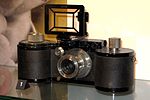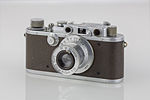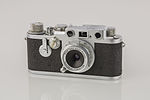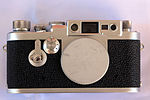Leica III
Appearance
 Leica IIIf fitted with a Summarit 50mm f/1.5 and a viewfinder. This particular model does not feature a self-timer. | |
| Overview | |
|---|---|
| Type | 35 mm rangefinder camera |
| Lens | |
| Lens mount | M39 lens mount |
| Focusing | |
| Focus | manual |
| Exposure/metering | |
| Exposure | manual |
| Flash | |
| Flash | cold shoe |
The Leica III is a rangefinder camera introduced by Leica in 1933, and produced in parallel with the Leica II series. Several models were produced over the years, with significant improvements.
The Leica III uses a coupled rangefinder distinct from the viewfinder. The viewfinder is set for a 50mm lens; use of shorter or longer lenses requires installing an alternate viewfinder on the accessory socket.[1]
| Model name | Manufacturing dates | Features or improvements | |
|---|---|---|---|
| Leica F (Leica III) | 1933–1939 | like II but with slow speeds on frontal dial * | 
|
| Leica 250 | 1933–1946 | Leica III or IIIa with 250-image magazines (10 metres of film) | 
|
| Leica G (Leica IIIa) | 1935–1940 | adds 1/1000 speed | 
|
| Leica IIIb | 1938–1940 | Rangefinder and view windows closer together | 
|
| Leica IIIc | 1940–1951 | die-cast body, slightly longer, redesigned shutter featuring ball bearings | 
|
| Leica IIId | 1940–1945 | Very rare, only 427 were built | |
| Leica IIIf | 1950–1956 | Introduced in time for Christmas 1950. Featured in-camera user selectable flash synchronization for the multitude of flash bulbs then available. Two versions produced, (1950-52) with non geometric shutter speeds and had black flash synchro numbers. Collectors refer to this model as a "Black Dial, aka BD". Second version (1953-56) switched to modern geometric speeds and was distinguished by red lettering on flash synchro numbers. Collectors refer to this model as a "Red Dial, aka RD". A self-timer was offered as a factory installed option in 1954. Many owners of the first IIIf version opted to send their cameras to Leica for self-timer retrofits. Collectors add the suffix ST (self timer) to the BD and RD nomenclature. BDST and RDST are used to identify models with self timers. | 
|
| Leica IIIg | 1957–1960 | change in body configuration to facilitate manufacture of larger and brighter viewfinder. Projected frame lines and automatic parallax correction for 50 and 90mm lenses. Rare. | 
|
Accessories and miscellaneous images
-
With a 28mm wide-angle lens and optional viewfinder
-
With a 400mm Telyt lens
-
With an adapter for stereo-photography
-
Orange filter for the Leica III
-
Self-portrait of Stanley Kubrick with a Leica III
-
Othographic views of a Leica IIIf with Summicron lens
-
Leica IIIc with bellows
Notes and references
- Image for Leica F is actually model IIIa
External links
Wikimedia Commons has media related to Leica III.
- Leica III by Karen Nakamura
- Leica III by luis triguez
- Leica IIIc by luis triguez
- Leica IIIf RDST by luis triguez
- Leica IIIf 3D model by Artem Lynnik
- History of the Screw Mount Leicas
- Leica III made since 1933
- Leica Screwmount







